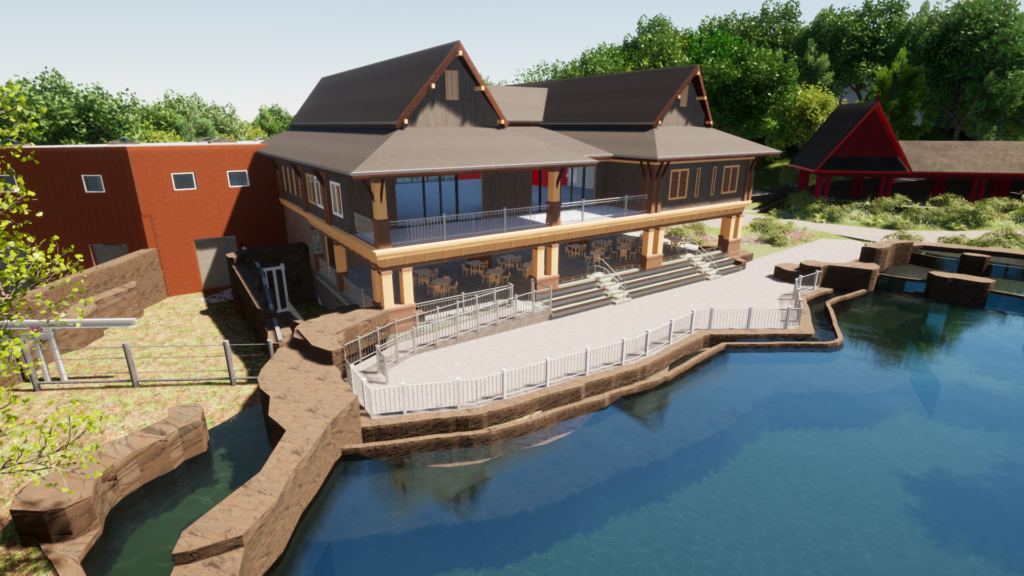Summary of Cincinnati Zoo Prioritizes Sustainability in Construction of New Elephant Trek Habitat:
The Cincinnati Zoo & Botanical Garden is enhancing sustainability in its new Elephant Trek habitat, scheduled to open later in 2024. The 5-acre habitat will feature LEED-certified buildings, utilize stormwater collected in tanks for water features, and be predominantly powered by solar panels. Mark Fisher, the Zoo’s VP of facilities and sustainability, highlighted the innovative use of captured rainwater for the elephants’ pool and other habitat water needs, benefiting local water management and reducing utility costs. The Zoo, known as the Greenest Zoo in America®, alongside its water sustainability sponsor Roto-Rooter, continues to focus on reducing fresh water usage. Dr. Lily Maynard, the director of global conservation, emphasized the Zoo’s commitment to wildlife conservation, including active involvement in Asian elephant conservation efforts, to support these animals in the wild, aligning with the opening of Elephant Trek.
– Cincinnati Zoo employs sustainable building practices for the new Elephant Trek habitat
– The integration of advanced water reclamation systems to benefit both the zoo and the local community
– Cincinnati Zoo advances global conservation efforts, connecting local initiatives to worldwide environmental stewardship
– Implementation of renewable energy sources significantly reduces the zoo’s carbon footprint
– Education and community involvement play a crucial role in the zoo’s sustainability and conservation efforts
Cincinnati Zoo & Botanical Garden stands at the forefront of combining wildlife conservation with sustainable zoo management. As the zoo embarks on constructing the new five-acre Elephant Trek habitat, a meticulous approach towards sustainability is visibly integrated into every aspect of the project. This initiative resonates deeply with the zoo’s mission of promoting wildlife conservation while advocating environmental stewardship.
A groundbreaking feature of the Elephant Trek habitat is its commitment to sustainable building practices, including the LEED certification of all constructed buildings. LEED, or Leadership in Energy and Environmental Design, is a globally recognized symbol of excellence in green building. Facilities achieving LEED certification meet the highest environmental performance standards, emphasizing energy-efficient, water-efficient, and reduction in carbon emissions strategies.
The zoo’s innovative water management strategy exemplifies its dedication to sustainability. Capturing rainwater to fill the quarter-million-gallon pool for the zoo’s elephants and to maintain waterfalls and streams throughout the habitat is not just an impressive engineering feat; it’s a testament to the zoo’s commitment to reducing its ecological footprint. This method of reusing rainwater conserves a precious natural resource. It mitigates the risk of water overflow into the neighboring areas and the Ohio River, showcasing an excellent example of how zoos can play a pivotal role in local environmental management.
Beyond water conservation, Cincinnati Zoo leverages solar energy to meet the habitat’s power needs. The substantial investment in solar panels, including a 165 kW array atop the elephant barn, is a beacon of sustainable energy use in animal care facilities. By drawing most of the habitat’s power from solar energy, the zoo significantly reduces fossil fuel consumption, aligning with global efforts to combat climate change.
Central to the zoo’s efforts in sustainability is its global conservation initiatives. Cincinnati Zoo not only focuses on the well-being of animals in its care but also engages in active conservation work to ensure the survival of elephant populations in the wild. This dual approach underscores zoological institutions’ critical role in conservation, bridging the gap between local projects and global environmental goals.
Educational programs and community engagement initiatives supplement the physical sustainability efforts of the Elephant Trek habitat. The zoo fosters a community committed to protecting natural resources and wildlife by informing visitors about the importance of conservation and sustainable practices. These educational efforts enrich the visitor experience, providing deeper insights into the importance of each individual’s role in environmental stewardship.
In summary, Cincinnati Zoo & Botanical Garden’s construction of the new Elephant Trek habitat is a hallmark of sustainable zoo management and wildlife conservation. The zoo sets a precedent for environmental responsibility within and beyond the zoological community by integrating green building practices, innovative water reclamation systems, renewable energy sources, and a robust educational framework. The Elephant Trek habitat provides a better home for its elephants and serves as a sustainable model, demonstrating the feasibility and importance of such practices in conservation efforts worldwide.

